Conflict Management at the Workplace: A Comprehensive Report
VerifiedAdded on 2020/03/28
|6
|1514
|62
Report
AI Summary
This report delves into the multifaceted issue of conflict in the workplace, defining it as disagreements between individuals or groups concerning ideas or interests. It highlights that conflict is not always negative, as it can promote personal growth, innovation, accountability, and mutual understanding. However, it also acknowledges the negative impacts, such as reduced productivity, lack of cohesion, and poor decision-making. The report explores various methods for resolving workplace conflict, including accommodating, collaborating, avoiding, negotiating, and compromising. These strategies are discussed in detail, offering practical approaches for managers to handle disputes effectively. The conclusion emphasizes the importance of conflict management skills for both small business managers and organizational leaders to mitigate the negative effects and leverage the positive outcomes of workplace disagreements.
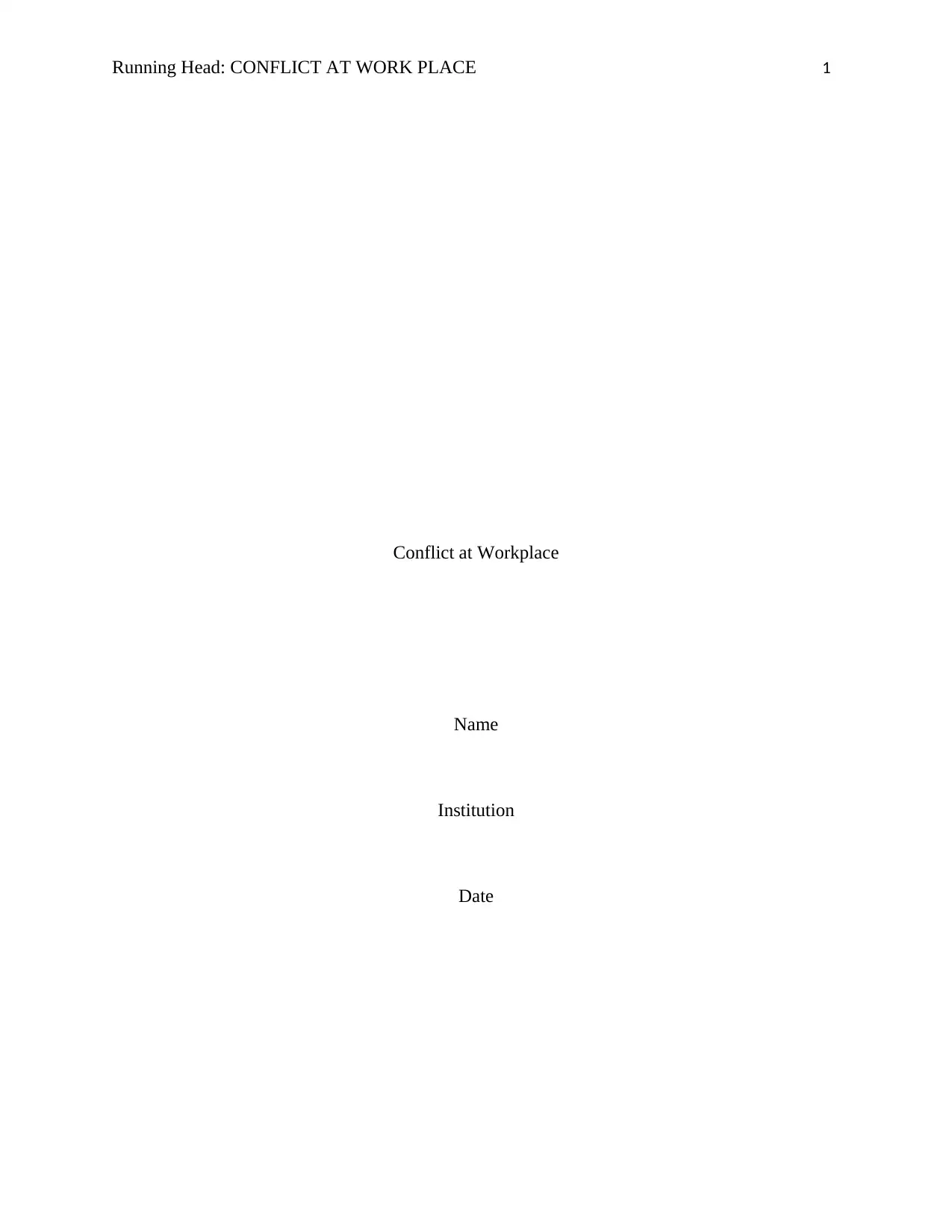
Running Head: CONFLICT AT WORK PLACE 1
Conflict at Workplace
Name
Institution
Date
Conflict at Workplace
Name
Institution
Date
Paraphrase This Document
Need a fresh take? Get an instant paraphrase of this document with our AI Paraphraser
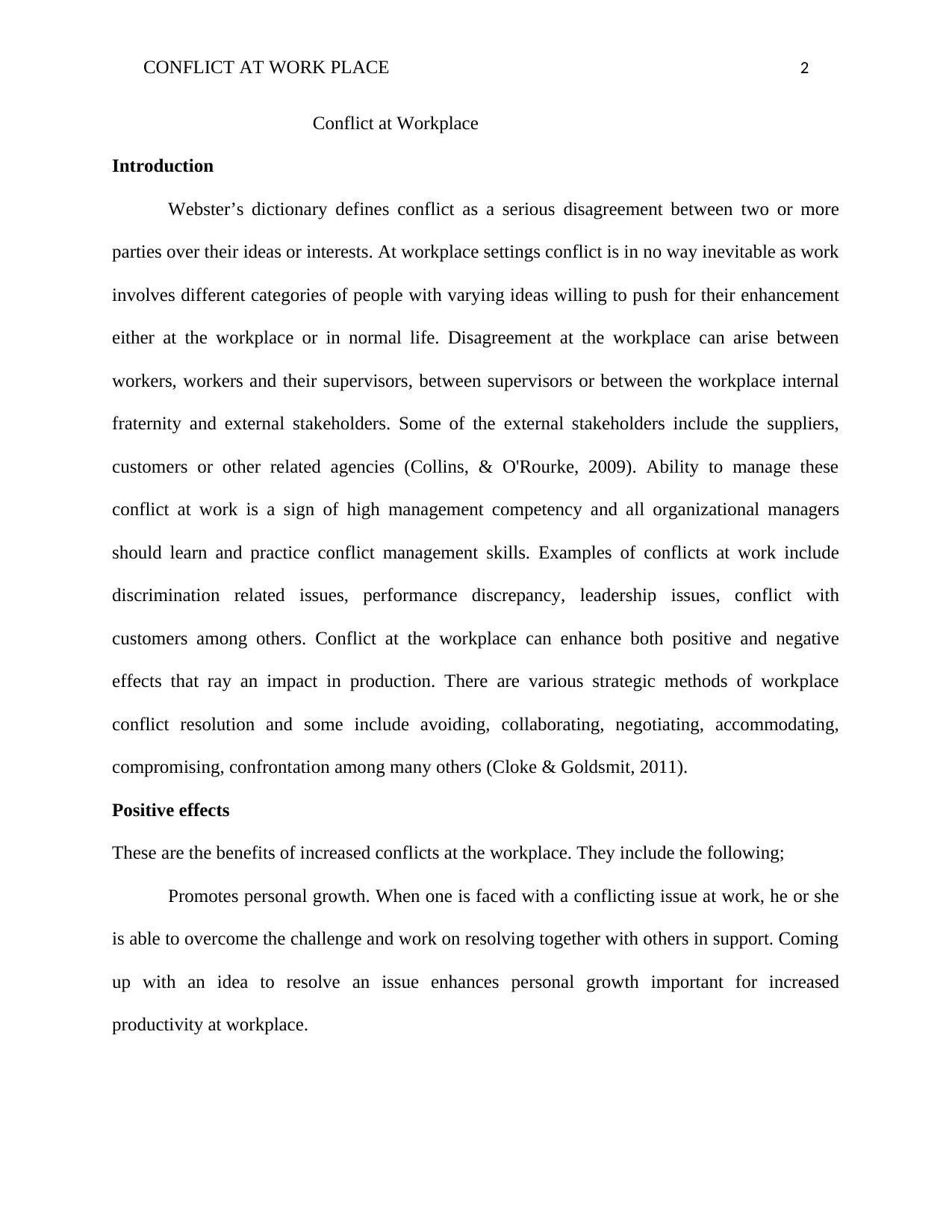
CONFLICT AT WORK PLACE 2
Conflict at Workplace
Introduction
Webster’s dictionary defines conflict as a serious disagreement between two or more
parties over their ideas or interests. At workplace settings conflict is in no way inevitable as work
involves different categories of people with varying ideas willing to push for their enhancement
either at the workplace or in normal life. Disagreement at the workplace can arise between
workers, workers and their supervisors, between supervisors or between the workplace internal
fraternity and external stakeholders. Some of the external stakeholders include the suppliers,
customers or other related agencies (Collins, & O'Rourke, 2009). Ability to manage these
conflict at work is a sign of high management competency and all organizational managers
should learn and practice conflict management skills. Examples of conflicts at work include
discrimination related issues, performance discrepancy, leadership issues, conflict with
customers among others. Conflict at the workplace can enhance both positive and negative
effects that ray an impact in production. There are various strategic methods of workplace
conflict resolution and some include avoiding, collaborating, negotiating, accommodating,
compromising, confrontation among many others (Cloke & Goldsmit, 2011).
Positive effects
These are the benefits of increased conflicts at the workplace. They include the following;
Promotes personal growth. When one is faced with a conflicting issue at work, he or she
is able to overcome the challenge and work on resolving together with others in support. Coming
up with an idea to resolve an issue enhances personal growth important for increased
productivity at workplace.
Conflict at Workplace
Introduction
Webster’s dictionary defines conflict as a serious disagreement between two or more
parties over their ideas or interests. At workplace settings conflict is in no way inevitable as work
involves different categories of people with varying ideas willing to push for their enhancement
either at the workplace or in normal life. Disagreement at the workplace can arise between
workers, workers and their supervisors, between supervisors or between the workplace internal
fraternity and external stakeholders. Some of the external stakeholders include the suppliers,
customers or other related agencies (Collins, & O'Rourke, 2009). Ability to manage these
conflict at work is a sign of high management competency and all organizational managers
should learn and practice conflict management skills. Examples of conflicts at work include
discrimination related issues, performance discrepancy, leadership issues, conflict with
customers among others. Conflict at the workplace can enhance both positive and negative
effects that ray an impact in production. There are various strategic methods of workplace
conflict resolution and some include avoiding, collaborating, negotiating, accommodating,
compromising, confrontation among many others (Cloke & Goldsmit, 2011).
Positive effects
These are the benefits of increased conflicts at the workplace. They include the following;
Promotes personal growth. When one is faced with a conflicting issue at work, he or she
is able to overcome the challenge and work on resolving together with others in support. Coming
up with an idea to resolve an issue enhances personal growth important for increased
productivity at workplace.
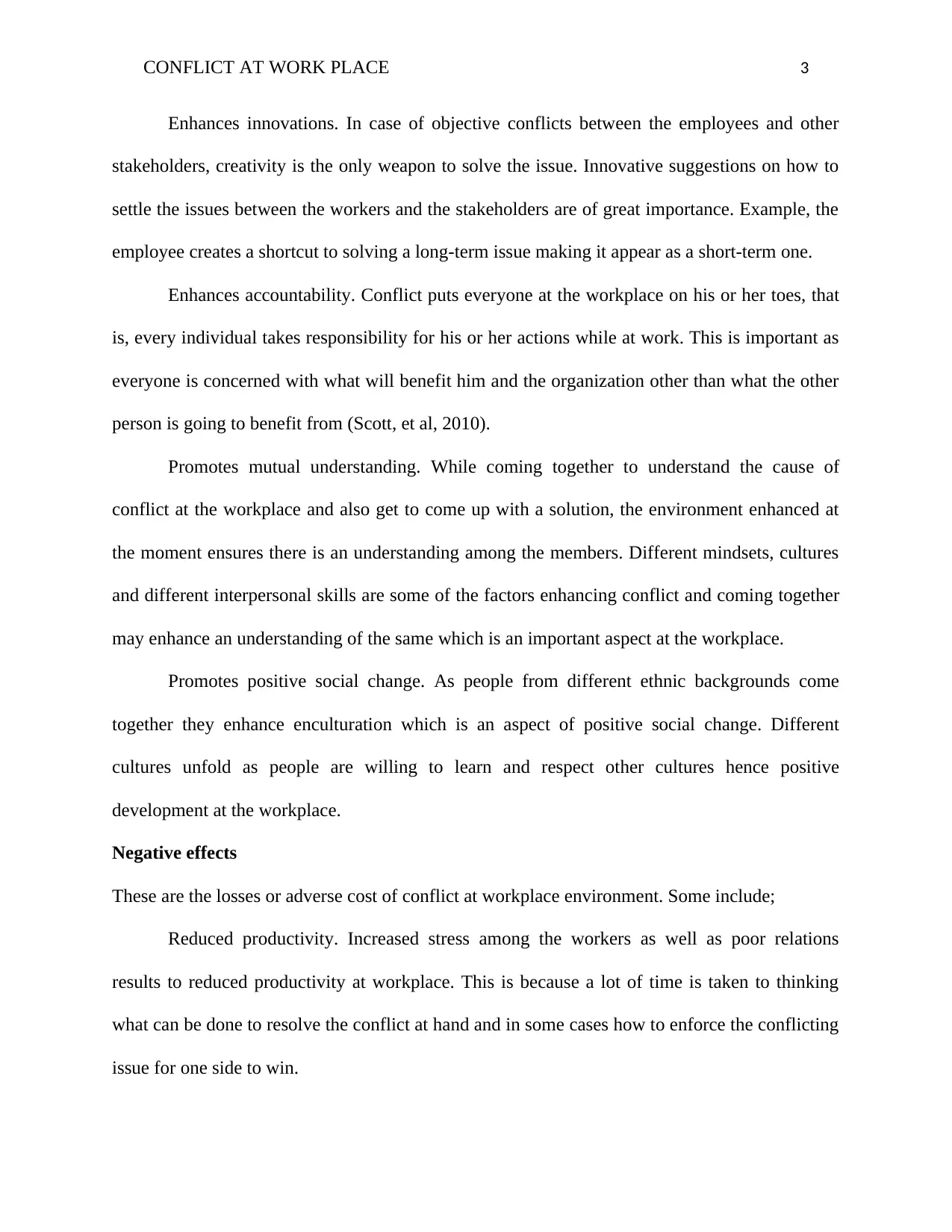
CONFLICT AT WORK PLACE 3
Enhances innovations. In case of objective conflicts between the employees and other
stakeholders, creativity is the only weapon to solve the issue. Innovative suggestions on how to
settle the issues between the workers and the stakeholders are of great importance. Example, the
employee creates a shortcut to solving a long-term issue making it appear as a short-term one.
Enhances accountability. Conflict puts everyone at the workplace on his or her toes, that
is, every individual takes responsibility for his or her actions while at work. This is important as
everyone is concerned with what will benefit him and the organization other than what the other
person is going to benefit from (Scott, et al, 2010).
Promotes mutual understanding. While coming together to understand the cause of
conflict at the workplace and also get to come up with a solution, the environment enhanced at
the moment ensures there is an understanding among the members. Different mindsets, cultures
and different interpersonal skills are some of the factors enhancing conflict and coming together
may enhance an understanding of the same which is an important aspect at the workplace.
Promotes positive social change. As people from different ethnic backgrounds come
together they enhance enculturation which is an aspect of positive social change. Different
cultures unfold as people are willing to learn and respect other cultures hence positive
development at the workplace.
Negative effects
These are the losses or adverse cost of conflict at workplace environment. Some include;
Reduced productivity. Increased stress among the workers as well as poor relations
results to reduced productivity at workplace. This is because a lot of time is taken to thinking
what can be done to resolve the conflict at hand and in some cases how to enforce the conflicting
issue for one side to win.
Enhances innovations. In case of objective conflicts between the employees and other
stakeholders, creativity is the only weapon to solve the issue. Innovative suggestions on how to
settle the issues between the workers and the stakeholders are of great importance. Example, the
employee creates a shortcut to solving a long-term issue making it appear as a short-term one.
Enhances accountability. Conflict puts everyone at the workplace on his or her toes, that
is, every individual takes responsibility for his or her actions while at work. This is important as
everyone is concerned with what will benefit him and the organization other than what the other
person is going to benefit from (Scott, et al, 2010).
Promotes mutual understanding. While coming together to understand the cause of
conflict at the workplace and also get to come up with a solution, the environment enhanced at
the moment ensures there is an understanding among the members. Different mindsets, cultures
and different interpersonal skills are some of the factors enhancing conflict and coming together
may enhance an understanding of the same which is an important aspect at the workplace.
Promotes positive social change. As people from different ethnic backgrounds come
together they enhance enculturation which is an aspect of positive social change. Different
cultures unfold as people are willing to learn and respect other cultures hence positive
development at the workplace.
Negative effects
These are the losses or adverse cost of conflict at workplace environment. Some include;
Reduced productivity. Increased stress among the workers as well as poor relations
results to reduced productivity at workplace. This is because a lot of time is taken to thinking
what can be done to resolve the conflict at hand and in some cases how to enforce the conflicting
issue for one side to win.
⊘ This is a preview!⊘
Do you want full access?
Subscribe today to unlock all pages.

Trusted by 1+ million students worldwide
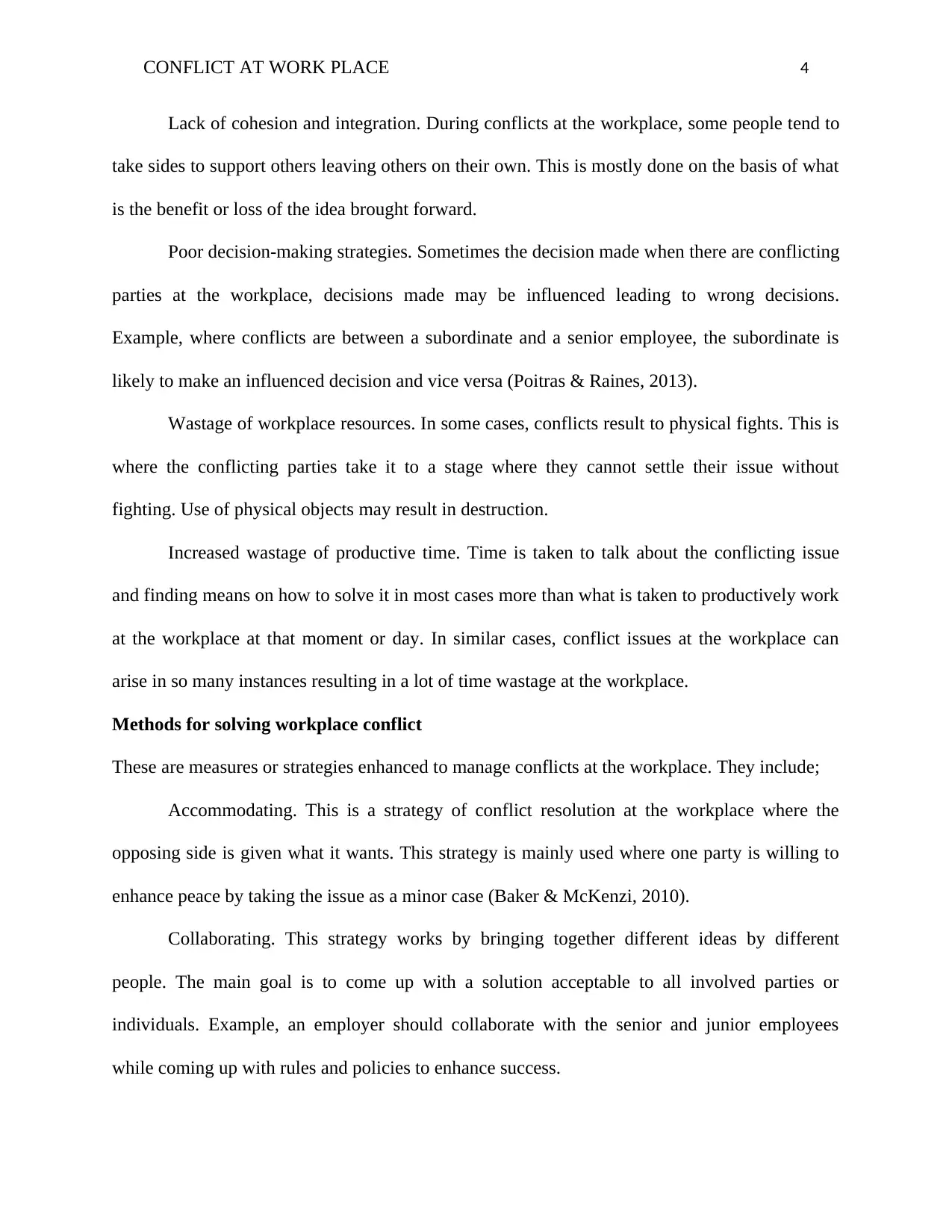
CONFLICT AT WORK PLACE 4
Lack of cohesion and integration. During conflicts at the workplace, some people tend to
take sides to support others leaving others on their own. This is mostly done on the basis of what
is the benefit or loss of the idea brought forward.
Poor decision-making strategies. Sometimes the decision made when there are conflicting
parties at the workplace, decisions made may be influenced leading to wrong decisions.
Example, where conflicts are between a subordinate and a senior employee, the subordinate is
likely to make an influenced decision and vice versa (Poitras & Raines, 2013).
Wastage of workplace resources. In some cases, conflicts result to physical fights. This is
where the conflicting parties take it to a stage where they cannot settle their issue without
fighting. Use of physical objects may result in destruction.
Increased wastage of productive time. Time is taken to talk about the conflicting issue
and finding means on how to solve it in most cases more than what is taken to productively work
at the workplace at that moment or day. In similar cases, conflict issues at the workplace can
arise in so many instances resulting in a lot of time wastage at the workplace.
Methods for solving workplace conflict
These are measures or strategies enhanced to manage conflicts at the workplace. They include;
Accommodating. This is a strategy of conflict resolution at the workplace where the
opposing side is given what it wants. This strategy is mainly used where one party is willing to
enhance peace by taking the issue as a minor case (Baker & McKenzi, 2010).
Collaborating. This strategy works by bringing together different ideas by different
people. The main goal is to come up with a solution acceptable to all involved parties or
individuals. Example, an employer should collaborate with the senior and junior employees
while coming up with rules and policies to enhance success.
Lack of cohesion and integration. During conflicts at the workplace, some people tend to
take sides to support others leaving others on their own. This is mostly done on the basis of what
is the benefit or loss of the idea brought forward.
Poor decision-making strategies. Sometimes the decision made when there are conflicting
parties at the workplace, decisions made may be influenced leading to wrong decisions.
Example, where conflicts are between a subordinate and a senior employee, the subordinate is
likely to make an influenced decision and vice versa (Poitras & Raines, 2013).
Wastage of workplace resources. In some cases, conflicts result to physical fights. This is
where the conflicting parties take it to a stage where they cannot settle their issue without
fighting. Use of physical objects may result in destruction.
Increased wastage of productive time. Time is taken to talk about the conflicting issue
and finding means on how to solve it in most cases more than what is taken to productively work
at the workplace at that moment or day. In similar cases, conflict issues at the workplace can
arise in so many instances resulting in a lot of time wastage at the workplace.
Methods for solving workplace conflict
These are measures or strategies enhanced to manage conflicts at the workplace. They include;
Accommodating. This is a strategy of conflict resolution at the workplace where the
opposing side is given what it wants. This strategy is mainly used where one party is willing to
enhance peace by taking the issue as a minor case (Baker & McKenzi, 2010).
Collaborating. This strategy works by bringing together different ideas by different
people. The main goal is to come up with a solution acceptable to all involved parties or
individuals. Example, an employer should collaborate with the senior and junior employees
while coming up with rules and policies to enhance success.
Paraphrase This Document
Need a fresh take? Get an instant paraphrase of this document with our AI Paraphraser
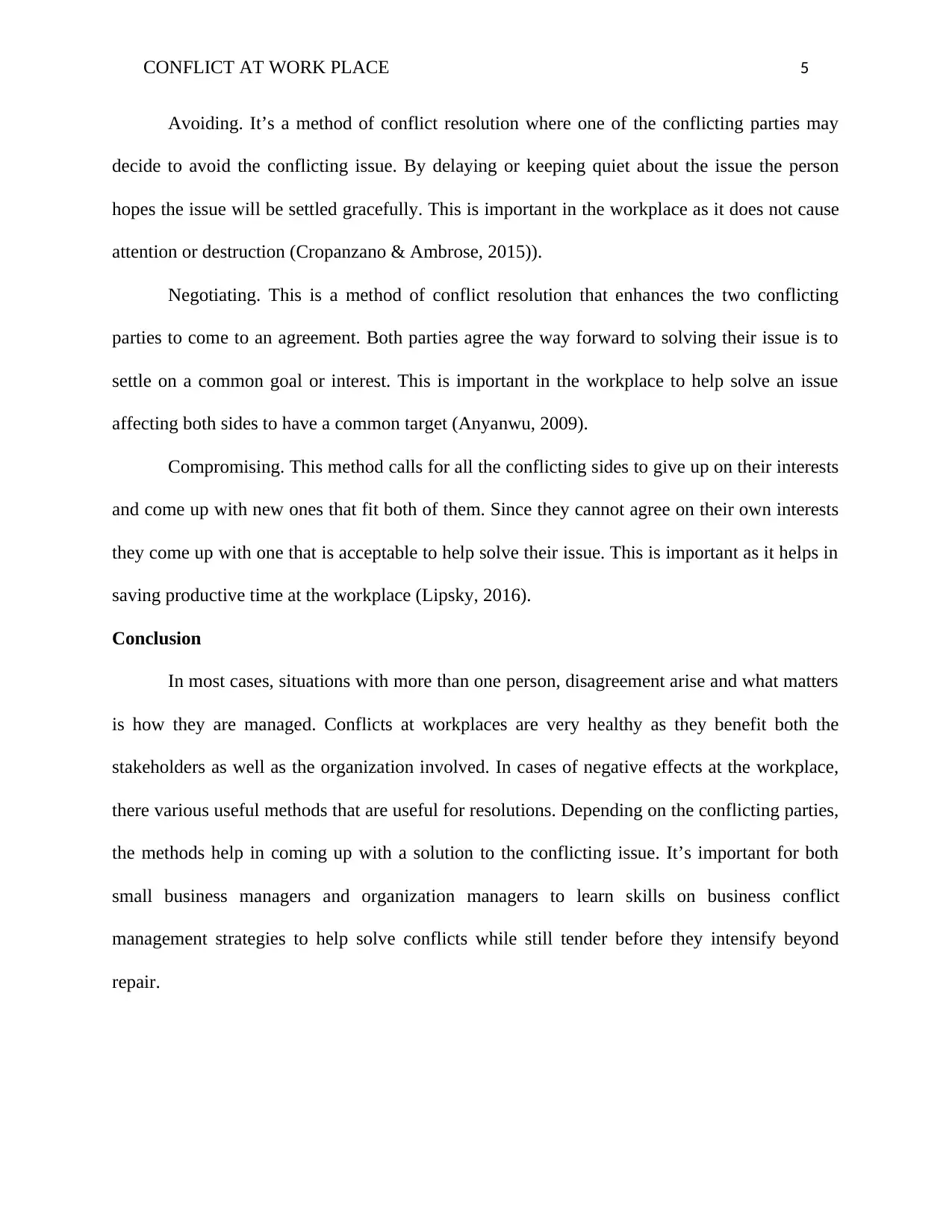
CONFLICT AT WORK PLACE 5
Avoiding. It’s a method of conflict resolution where one of the conflicting parties may
decide to avoid the conflicting issue. By delaying or keeping quiet about the issue the person
hopes the issue will be settled gracefully. This is important in the workplace as it does not cause
attention or destruction (Cropanzano & Ambrose, 2015)).
Negotiating. This is a method of conflict resolution that enhances the two conflicting
parties to come to an agreement. Both parties agree the way forward to solving their issue is to
settle on a common goal or interest. This is important in the workplace to help solve an issue
affecting both sides to have a common target (Anyanwu, 2009).
Compromising. This method calls for all the conflicting sides to give up on their interests
and come up with new ones that fit both of them. Since they cannot agree on their own interests
they come up with one that is acceptable to help solve their issue. This is important as it helps in
saving productive time at the workplace (Lipsky, 2016).
Conclusion
In most cases, situations with more than one person, disagreement arise and what matters
is how they are managed. Conflicts at workplaces are very healthy as they benefit both the
stakeholders as well as the organization involved. In cases of negative effects at the workplace,
there various useful methods that are useful for resolutions. Depending on the conflicting parties,
the methods help in coming up with a solution to the conflicting issue. It’s important for both
small business managers and organization managers to learn skills on business conflict
management strategies to help solve conflicts while still tender before they intensify beyond
repair.
Avoiding. It’s a method of conflict resolution where one of the conflicting parties may
decide to avoid the conflicting issue. By delaying or keeping quiet about the issue the person
hopes the issue will be settled gracefully. This is important in the workplace as it does not cause
attention or destruction (Cropanzano & Ambrose, 2015)).
Negotiating. This is a method of conflict resolution that enhances the two conflicting
parties to come to an agreement. Both parties agree the way forward to solving their issue is to
settle on a common goal or interest. This is important in the workplace to help solve an issue
affecting both sides to have a common target (Anyanwu, 2009).
Compromising. This method calls for all the conflicting sides to give up on their interests
and come up with new ones that fit both of them. Since they cannot agree on their own interests
they come up with one that is acceptable to help solve their issue. This is important as it helps in
saving productive time at the workplace (Lipsky, 2016).
Conclusion
In most cases, situations with more than one person, disagreement arise and what matters
is how they are managed. Conflicts at workplaces are very healthy as they benefit both the
stakeholders as well as the organization involved. In cases of negative effects at the workplace,
there various useful methods that are useful for resolutions. Depending on the conflicting parties,
the methods help in coming up with a solution to the conflicting issue. It’s important for both
small business managers and organization managers to learn skills on business conflict
management strategies to help solve conflicts while still tender before they intensify beyond
repair.
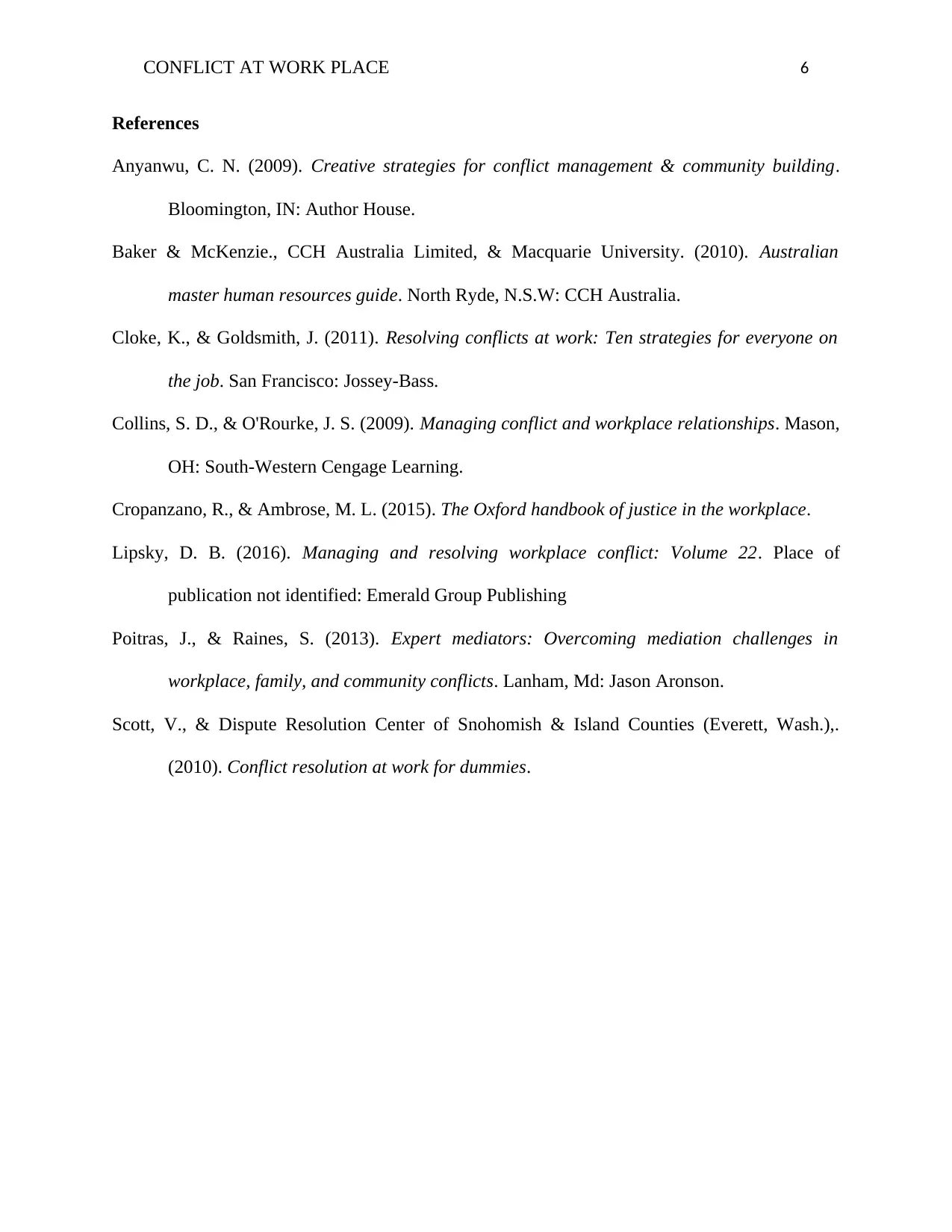
CONFLICT AT WORK PLACE 6
References
Anyanwu, C. N. (2009). Creative strategies for conflict management & community building.
Bloomington, IN: Author House.
Baker & McKenzie., CCH Australia Limited, & Macquarie University. (2010). Australian
master human resources guide. North Ryde, N.S.W: CCH Australia.
Cloke, K., & Goldsmith, J. (2011). Resolving conflicts at work: Ten strategies for everyone on
the job. San Francisco: Jossey-Bass.
Collins, S. D., & O'Rourke, J. S. (2009). Managing conflict and workplace relationships. Mason,
OH: South-Western Cengage Learning.
Cropanzano, R., & Ambrose, M. L. (2015). The Oxford handbook of justice in the workplace.
Lipsky, D. B. (2016). Managing and resolving workplace conflict: Volume 22. Place of
publication not identified: Emerald Group Publishing
Poitras, J., & Raines, S. (2013). Expert mediators: Overcoming mediation challenges in
workplace, family, and community conflicts. Lanham, Md: Jason Aronson.
Scott, V., & Dispute Resolution Center of Snohomish & Island Counties (Everett, Wash.),.
(2010). Conflict resolution at work for dummies.
References
Anyanwu, C. N. (2009). Creative strategies for conflict management & community building.
Bloomington, IN: Author House.
Baker & McKenzie., CCH Australia Limited, & Macquarie University. (2010). Australian
master human resources guide. North Ryde, N.S.W: CCH Australia.
Cloke, K., & Goldsmith, J. (2011). Resolving conflicts at work: Ten strategies for everyone on
the job. San Francisco: Jossey-Bass.
Collins, S. D., & O'Rourke, J. S. (2009). Managing conflict and workplace relationships. Mason,
OH: South-Western Cengage Learning.
Cropanzano, R., & Ambrose, M. L. (2015). The Oxford handbook of justice in the workplace.
Lipsky, D. B. (2016). Managing and resolving workplace conflict: Volume 22. Place of
publication not identified: Emerald Group Publishing
Poitras, J., & Raines, S. (2013). Expert mediators: Overcoming mediation challenges in
workplace, family, and community conflicts. Lanham, Md: Jason Aronson.
Scott, V., & Dispute Resolution Center of Snohomish & Island Counties (Everett, Wash.),.
(2010). Conflict resolution at work for dummies.
⊘ This is a preview!⊘
Do you want full access?
Subscribe today to unlock all pages.

Trusted by 1+ million students worldwide
1 out of 6
Related Documents
Your All-in-One AI-Powered Toolkit for Academic Success.
+13062052269
info@desklib.com
Available 24*7 on WhatsApp / Email
![[object Object]](/_next/static/media/star-bottom.7253800d.svg)
Unlock your academic potential
Copyright © 2020–2025 A2Z Services. All Rights Reserved. Developed and managed by ZUCOL.




